Kicker L5 User Manual

L5 Technical Manual
Kicker Solo-Baric L5-Series Subwoofers
Recommended Applications / Version 2.0
June 13, 2002

Features
yMica Filled Polypropylene Cone A high performance cone that lives up to the Solo-Baric® standard. Any normal cone would crumble under the stress that the Solo-Baric® L5 motor structure puts on the cone. This will give you deeper and stronger bass at higher listening levels with less distortion.
yKicker engineered rear cone brace In order to keep up with the demands on the cone at extreme listening levels, the rear brace has been redesigned and strengthened to reduce the cone flex at these listening levels. The brace works in conjunction with the other components of the cone to insure that cone flex does not decrease the output of the woofer.
yIncreased Surround Radius In order to achieve high SPL, the woofer needs to have an extreme Xmax (the distance the woofer moves in one direction). In order to do this, the woofer needs a large enough surround that will allow the cone to reach Xmax while handling the stress of doing so. The Solo-Baric® L5 borrows surround technology from it’s brother the L7 and handles this requirement with ease.
yWARG (Wrap ARound Gasket) Instead of using cork gaskets, which can separate, the new Solo-Baric® L5s have a one piece gasket that wraps around the front and back of the mounting flange. It is more durable and ergonomically pleasing to the eye. The previous cork gaskets could tear off or if you were transplanting the speaker into another box, they could stay adhered to the old box causing you to order another gasket. These problems are eliminated with the new rubber gaskets. They not only look better, but also function better by eliminating the chance for air leaks.(provided the box is built correctly!) We still recommend if you are carpeting the box, to cut away any carpet that is under the woofer mounting flange.
ySSD (Spun Spoke Design) The basket not only looks impressive, but it is extremely functional. This stamped steel basket provides a solid foundation for the motor assembly insuring that all the parts work together in harmony and prevent shifting or misalignment. Without a solid foundation, the speaker’s various parts could shift under extreme excursion causing premature failure and add unwanted noise to the music. If misaligned, the voice coilcould rub the inner wall of the motor structure and thus exposing the bare windings, which would cause speaker failure. The same thing happens if the coil former rubs the pole-piece. The damaged former exposes the windings causing speaker failure. When other speakers are pushed to their limits they tend to make noises that add coloration to the music. When you’re LIVIN’LOUD you only want to hear the music the artist intended you to hear, not a bunch of unwanted ringing.
yPerimeter Venting Without the perimeter venting along the side of the speaker, hot air would be trapped in with the voice coil. This will cause the structure to heat up quicker and cause power compression, which results in decreased output, as well as shorter speaker life. Perimeter venting causes a vortex cooling effect around the coil which exchanges the hot air around the voice coil for cooler air outside the speaker. It also releases pressure from under the spider to allow the speaker to work in a more linear fashion. All of this translates into cooler operating temperatures which will allow the speaker to sound and perform better.
Kicker Solo-Baric L5-Series Subwoofers
Recommended Applications
Page 2

Features cont.
yBlackened One Piece Uniplate with Vented Hyper-Extended Pole
1.Provides enhanced heat transfer for cool operation and maximum power handling. The heat is transferred from the pole piece to the back plate, effectively acting like a radiator in an engine. This lowers the operating temperature of the voice coil. Note:The increase in temperature increases the impedance of the speak-
er. This results in lower output and is referred to as Power Compression.
2. Reduces non-linear magnetic fields around the voice coil gap for superior cone motion control. The extended pole assures the voice coil is always in the magnetic field when moving peak to peak. When the speaker reaches it’s Xmax, the voice coil is still in the gap between the pole piece and magnet structure due to its extended pole-piece.
3. Releases pressure under ISD for freer cone motion and enhanced low frequency response. Air trapped under the ISD is forced out though the pole-piece to allow the cone to move freely. Heat and pressure build up under the ISD and need to be released to allow the speaker to function properly.
yHigh-Temp Kapton® Voice Coil Former Heat is the primary enemy to the life of a speaker, which is one of the reasons we use Kapton® voice coil formers. Kapton® is a man-made product that is light, durable and heatresistant. The Kapton® former acts as an insulator to keep the heat of the voice coil from breaking down the adhesive that connects the voice coil to the cone. During high excursion and prolonged exposure to heat, the Kapton® former holds it’s shape and does not expand or contract. As a bonus, Kapton® is also a very quiet material during operation and does not discolor the music by adding unwanted sound
yISD (Inverted Structural Dome) Kicker was one of the first companies to switch to the Inverted Structural Dome. We have designed a cone with a groove for the ISD to lock into, further adding strength to the structure. When a cone reaches it’s peak it wants to buckle because it’s momentum keeps it moving out. The ISD provides structural support for the cone to resist buckling. NOTE: When the cone buckles, the output of the woofer decreases. Therefore, the ISD is not just a cosmetic thing, it is an integral part of the woofer to maintain it’s maximum performance.
yStitched Surround A signature of KICKER woofers has always been the stitched surround. It prevents the surround from separating from the cone at high excursions. When the woofer is moving back and forth it puts a lot of strain on the adhesive that is holding the surround to the cone and often causes the two to separate. Stitching the surround to the cone eliminates this from happening. If stitching were inexpensive, everybody would do it!
yDual Ultra-Length Voice Coils A speaker can obtain extreme Xmax only when the voice coil is long enough and can sustain the stress. Dual voice coils give the installer the option of several different wiring configurations compatible with any amplifier.
ySleeved High-Power Tinsel Lead Wires Resist lead breakage and power robbing resistance losses under demanding conditions. When a speaker is being pushed to it’s limits there is a lot of strain being put on the leads, especially on high performance woofers like the Solo-Baric® L5. Sleeving tinsel leads help strengthen them to resist breakage.
ySpring-Loaded Nickel Plated Terminals On a High Performance speaker like the Solo-Baric® L5, you would expect nothing less than a High Performance terminal. They allow the installer to use the maximum gauge wire to minimize power losses for the ultimate Ground Poundin’ system.
Kicker Solo-Baric L5-Series Subwoofers
Recommended Applications
Page 3
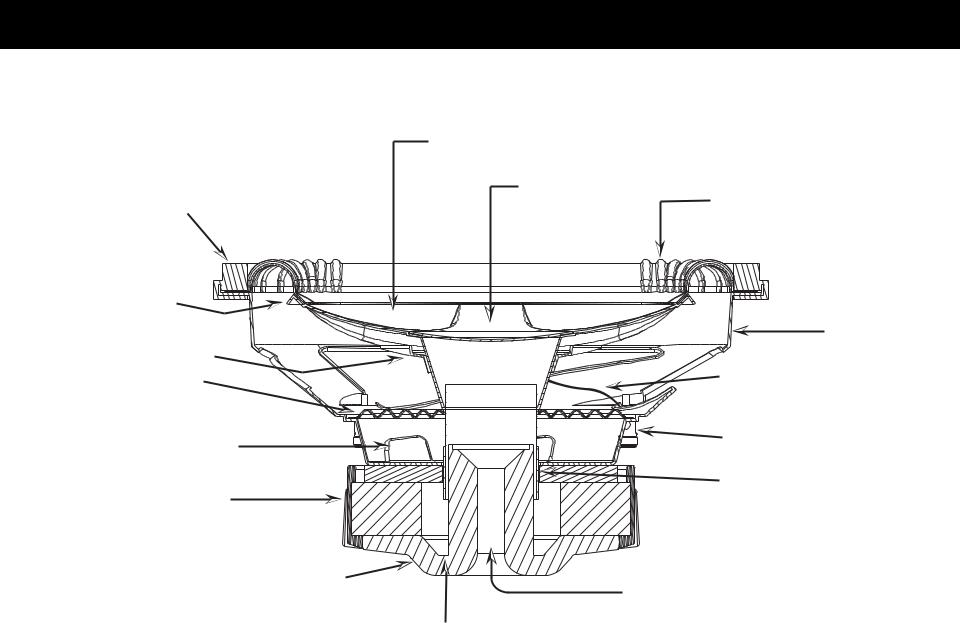
Subwoofers Series-L5 Barics-Solo Kicker
Applications Recommended
4 Page
L5 Cutaway View
Advanced cone materials With superior internal damping mean ultra-fast transient response and super-low distortion.
|
ISD (Inverted Structural Dome) |
Patent Pending |
|
WARG (Wrap ARound Gasket) Provides |
Tough, flexible surround With |
||
increases cone's resistance to |
|||
long-throw, positive-roll design |
|||
greater durability and resistance to separation |
|||
flex under pressure. |
|||
controls extreme cone excursions |
|||
while providing a superior seal. |
|||
|
|||
|
and is highly tear resistant. Ribbed |
||
|
|
||
|
|
corners ensure linear cone motion. |
ABS(Auxiliary Bracing Structure) |
Patented |
|
Adds rigidity to the outer edge of |
||
SSD (Spun Spoke Design) |
||
the cone to further reduce cone flex |
||
Enhances the cosmetics |
||
under extreme excursion. |
||
and provides a solid anti- |
||
|
||
Rear Cone Brace Adds rigidity |
resonant foundation for |
|
the motor assembly. |
||
to the cone structure. |
|
|
|
Sleeved High-Power Tinsel Lead Wires |
|
Durable resin-impregnated |
To resist lead breakage and power-robbing |
|
resistance. |
||
poly-cotton spider Provides |
||
|
||
precise coil alignment and |
|
|
critical cone motion control. |
Spring-Loaded nickel plated terminals |
|
|
||
Perimeter vents Create a vortex |
For solid connections with large gauge |
|
cooling effect around the voice coil. |
speaker wire. |
|
|
||
|
Multi-layer voice coil and Kapton® |
|
Rubberized boot Protects |
former Create superior magnetic |
|
massive magnet structure |
field and effectively dissipate heat. |
|
from chipping or breaking. |
|
|
One-Piece extended Pole, invented by Stillwater Designs, |
Vented pole piece |
|
creates a broad, symmetrical magnetic field for superior |
||
Eliminates noise and distortion |
||
power handling, precise voice coil control, and minimal |
||
caused by huge amounts of airflow |
||
deep bass distortion. |
||
created by extreme cone excursion. |
||
|
||
|
Deep bumped back plate Lets voice coil |
|
|
reach maximum excursion without bottoming-out. |

Thank you for your support of Kicker products, and especially our Solo-Baric® L5 (patent pending) square subwoofers. The Solo-Barics® SL5s are truly unique products in a world of round subwoofers. Our technical and R&D staffs have designed some extreme enclosures beyond the small sealed boxes Solo-Barics® are famous for. They have unleashed the awesome capabilities of the L5s.
In this paper we will explore some applications for the Solo-Baric L5 complete with box drawings and cut sheets plus some important information regarding the break-in period for this ground-breaking speaker.
Important Break-In Information
Due to the complex nature of the Solo-Baric L5s they require a little extra time to break-in. Especially in sealed enclosures, break-in is a must in order for woofers to produce optimum low bass response. Due to the high performance suspension system incorporated in the Solo-Barics® they are very stiff “out of the box”. Approximately two weeks of daily playing will allow the suspension to break-in and reach its optimum equilibrium. The “brokenin “ sub will exhibit stronger bass performance, smoother response, and greater low bass extension.
For those of you with more sophisticated audio equipment, the Solo-Barics can be broken-in on the test bench overnight with the following procedure.
Solo-Baric Freeair Break-in Procedure
1.Connect the speaker to a power amp of about fifty watts or more. The speaker should not be mounted in any enclosure - just freeair. Please make sure it will not walk off the bench while it is playing!
2.Connect an audio generator to the input of the power amp, and adjust the generator to approximately 45Hz for the S8L5, 35 Hz for the S10L5, 30 Hz for the S12L5, and 20 Hz for the S15L5.
3.Now adjust the gain on the amplifier and generator so that the cone is moving to Xmax. This can be determined visually by looking at the “blur depth” of the logo on the ISD. A close approximation will do. On the S8L5 this will be about 3/4”, on the S10L5 about 1”, on the S12L5 about 1”, and on the S15L5 about 1 1/4”.
NOTE: Keep in mind that as the speaker is used under normal conditions the break-in will continue, so if you don’t have time for the complete break-in period the speaker will still break-in itself under normal usage.
Kicker Solo-Baric L5-Series Subwoofers
Recommended Applications
Page 5

Sealed Enclosure Applications
The Kicker Solo-Baric SL5 woofers are designed to give more output than an equivalent round speaker. The SL5 is amazing when used in the recommended sealed boxes. These sealed enclosure SQ recommendations will give the smoothest response with the most energy at really low frequencies, around 20 to 30 Hz.
The recommended Compact sealed boxes are in line with our traditional Solo-Baric enclosures. They deliver massive amounts of high impact bass and can be driven with punishing levels of amplifier power.
One of the benefits of the L5-Series high performance suspension system is that the Solo-Barics can operate in larger sealed enclosures for ultra sound quality (SQ) applications without significantly sacrificing their power handling. This extra bass extension and smoothness can be obtained by simply using a larger sealed enclosure. The box can be “sized up” all the way up to the maximum SQ enclosure, which has a very flat response, with greatly extended sub bass.
Solo-Baric L5 series woofers also perform well in any sealed enclosure between the Compact and SQ sizes. These systems will exhibit some benefits of both (high impact and low extension) generally sounding more like the box to which they are most closely sized.
|
Recommended Enclosures |
|
|
Model |
- Moderate Efficiency - |
|
|
Compact |
SQ |
||
|
|||
|
|
|
|
|
|
|
|
S8L5 |
.33 cu.ft. Power Handling = 300W |
.75 cu.ft. Power Handling =300W |
|
|
9.34 l |
21.24 l |
|
S10L5 |
.66 cu.ft. Power Handling = 450W |
1.0 cu.ft. Power Handling =450W |
|
|
18.69 l |
28.32 l |
|
S12L5 |
.88 cu.ft. Power Handling = 600W |
2.0 cu.ft. Power Handling = 600W |
|
|
24.92 l |
56.64 l |
|
S15L5 |
1.5 cu.ft. Power Handling = 750W |
6.0 cu.ft. Power Handling = 750W |
|
|
42.48 l |
69.92 l |
NOTE: All sealed boxes should be 50% filled with loose polyfil. Allow about two weeks break-in time for the Solo-Barics to reach optimum low bass performance.
Kicker Solo-Baric L5-Series Subwoofers
Recommended Applications
Page 6
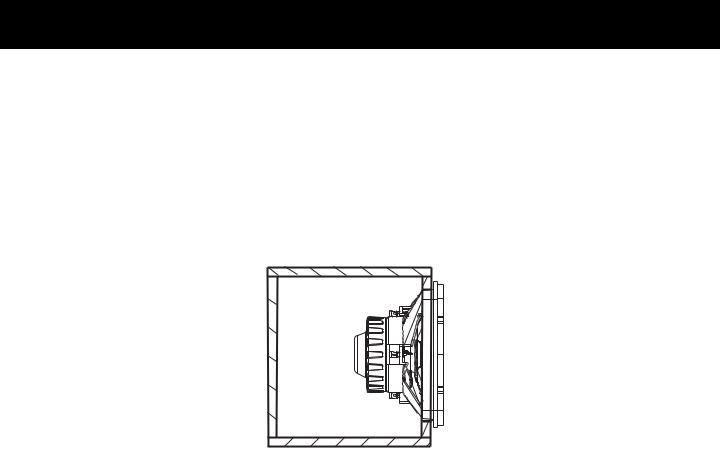
Characteristics of Sealed Enclosures
The most basic and simple of all speaker enclosures is the sealed box or acoustic suspension design.
The acoustic suspension design has several advantages; it is easy to build, easy to tune and offers high power handling, tight response and extended low end output. Acoustic suspension enclosures produce lower bass because they roll off at 12 dB per/octave. Cone motion is better controlled at all frequencies because of the constant pressure on the back side of the cone. This enables you to run more power to the woofer. They are called acoustic suspension enclosures because the air inside the box acts like a viscous brake to control the woofer. That is why the box needs to be sealed tight. If there are any air leaks the woofer cannot function properly because there is very little force being exerted back on the woofer.
Pros
1 - High power handling capability
2 - Extended low frequency response and smooth roll off (12 dB/octave). 3 - Excellent transient response.
4 - Tolerant of minor enclosure size variations.
5 - Easiest enclosure to build.
Cons
1 - Not as efficient as other designs.
Kicker Solo-Baric L5-Series Subwoofers
Recommended Applications
Page 7
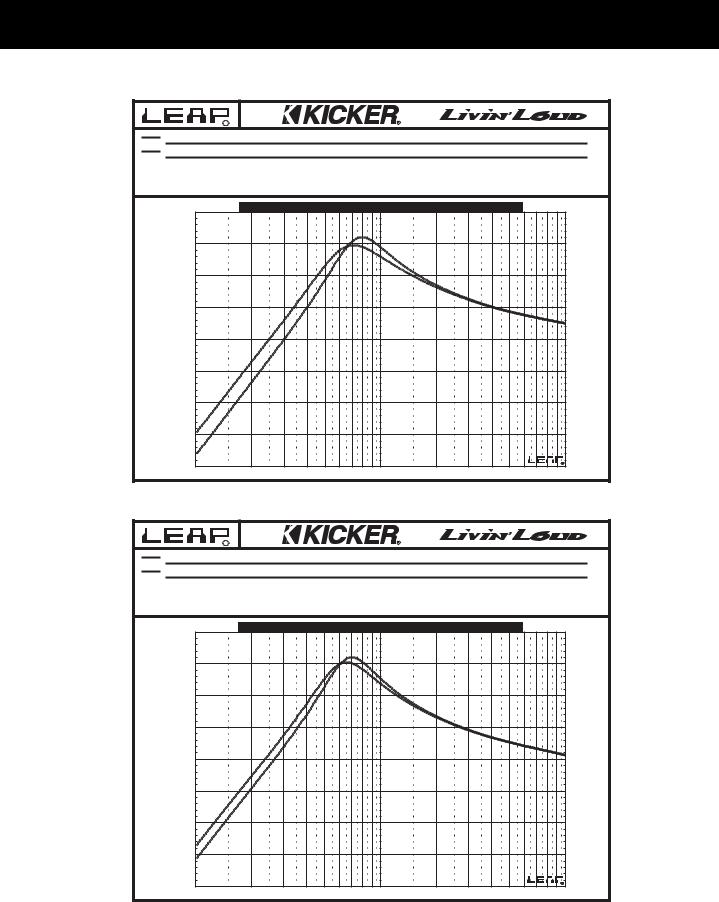
Sealed Box Response Curves
|
|
S8L5 .33cu.ft./.75cu.ft. |
|
|
|||
|
|
C |
|
|
|
|
|
S8L5 Compact Enclosure Response Curve |
|
|
|
|
|||
S8L5 SQ Enclosure Response Curve |
|
|
|
|
|||
90 |
dB |
G r a p h 1 > A c o u s t i c O n A x i s R e s p o n s e : S P L , P h a s e |
|
||||
85 |
|
|
|
|
|
|
|
80 |
|
|
|
|
|
|
|
75 |
|
|
|
|
|
|
|
70 |
|
|
|
|
|
|
|
65 |
|
|
|
|
|
|
|
60 |
|
|
|
|
|
|
|
55 |
|
|
|
|
|
|
|
50 |
|
|
|
|
|
|
C |
1 0 |
F r e q u e n c y |
5 0 |
1 0 0 |
H z |
5 0 0 |
1 K |
|
|
|
S10L5 .66cu.ft./1.0cu.ft. |
|
|
|||
|
|
C |
|
|
|
|
|
S10L5 Compact Enclosure Response Curve |
|
|
|
|
|||
S10L5 SQ Enclosure Response Curve |
|
|
|
|
|||
95 |
dB |
G r a p h 1 > A c o u s t i c O n A x i s R e s p o n s e : S P L , P h a s e |
|
||||
90 |
|
|
|
|
|
|
|
85 |
|
|
|
|
|
|
|
80 |
|
|
|
|
|
|
|
75 |
|
|
|
|
|
|
|
70 |
|
|
|
|
|
|
|
65 |
|
|
|
|
|
|
|
60 |
|
|
|
|
|
|
|
55 |
|
|
|
|
|
|
C |
1 0 |
F r e q u e n c y |
5 0 |
1 0 0 |
H z |
5 0 0 |
1 K |
|
Kicker Solo-Baric L5-Series Subwoofers
Recommended Applications
Page 8
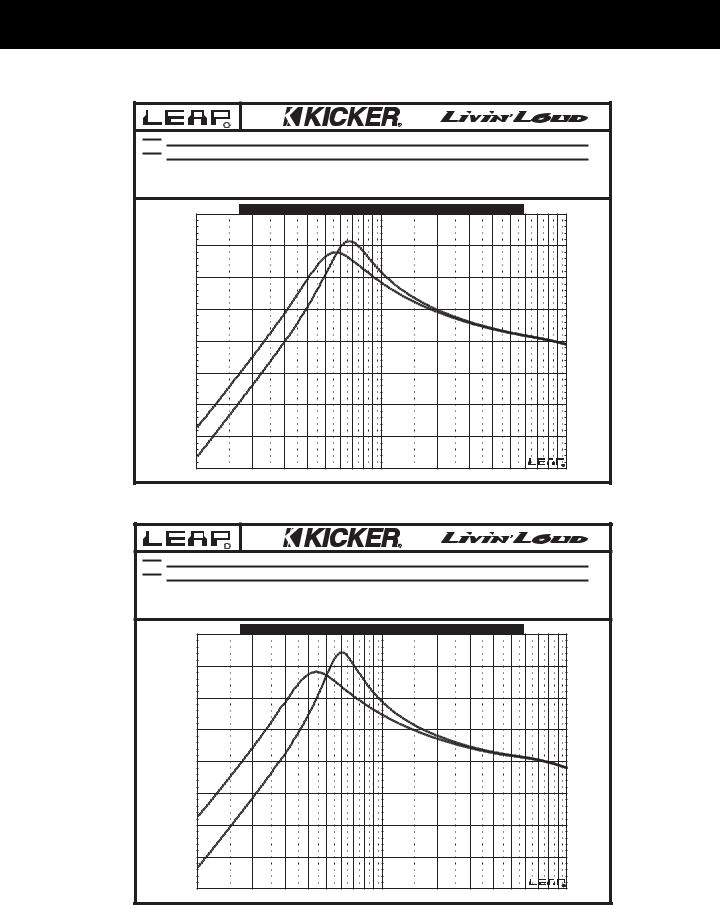
Sealed Box Response Curves
|
|
S12L5 .88cu.ft./2.0cu.ft. |
|
|
|||
|
|
C |
|
|
|
|
|
S12L5 Compact Enclosure Response Curve |
|
|
|
|
|||
S12L5 SQ Enclosure Response Curve |
|
|
|
|
|||
95 |
dB |
G r a p h 1 > A c o u s t i c O n A x i s R e s p o n s e : S P L , P h a s e |
|
||||
90 |
|
|
|
|
|
|
|
85 |
|
|
|
|
|
|
|
80 |
|
|
|
|
|
|
|
75 |
|
|
|
|
|
|
|
70 |
|
|
|
|
|
|
|
65 |
|
|
|
|
|
|
|
60 |
|
|
|
|
|
|
|
55 |
|
|
|
|
|
|
C |
1 0 |
F r e q u e n c y |
5 0 |
1 0 0 |
H z |
5 0 0 |
1 K |
|
|
|
S15L5 1.5cu.ft./6.0cu.ft. |
|
|
|||
|
|
C |
|
|
|
|
|
S15L5 Compact Enclosure Response Curve |
|
|
|
|
|||
S15L5 SQ Enclosure Response Curve |
|
|
|
|
|||
95 |
dB |
G r a p h 1 > A c o u s t i c O n A x i s R e s p o n s e : S P L , P h a s e |
|
||||
90 |
|
|
|
|
|
|
|
85 |
|
|
|
|
|
|
|
80 |
|
|
|
|
|
|
|
75 |
|
|
|
|
|
|
|
70 |
|
|
|
|
|
|
|
65 |
|
|
|
|
|
|
|
60 |
|
|
|
|
|
|
|
55 |
|
|
|
|
|
|
C |
1 0 |
F r e q u e n c y |
5 0 |
1 0 0 |
H z |
5 0 0 |
1 K |
|
Kicker Solo-Baric L5-Series Subwoofers
Recommended Applications
Page 9

Ported/Vented Enclosure Applications
Ported Solo-Barics incorporate massive slot loaded ports with ultra low air velocity for ground pounding street bass that will make your hair stand on end (if you have any left)! These are the enclosures of choice for outrageous street bass and high performance SPL contests.
The following chart shows three recommended ported enclosures for each Solo-Baric driver.
Compact has increased bass efficiency over a sealed enclosure, yet can still fit in tighter applications. It is the smallest design that will work well for each woofer. Although it is the smallest ported enclosure the output from 30 to 80 HZ will be considerably higher than that of a sealed box. This smallest vented design is for places where you can only give up the room normally taken up by two L5s in the normal small sealed boxes. The two other ported designs have proportionately more output in this region.
Street Bass is a medium sized enclosure that will kick out bass that can be heard for blocks away. And it does go LOW!
Finally, SPL / Deep Bass is a large enclosure that has it all. It is high efficiency and will deliver the output needed to win SPL contests, yet low frequencies go all the way down to the basement - with power that will shake the foundations! We’re talking truly awesome.
If space is not at a premium and you want to get the most from your Solo-Baric L5, try one of these designs. You won’t be disappointed. Note: You must add the port volume to the volume of the box! See the cut sheets.
|
|
Recommended Ported Enclosure |
|
|
|
– High Efficiency – |
|
Model |
Compact |
Street Bass |
SPL / Deep Bass |
|
|
|
|
S8L5 |
.66 cu.ft. + port, |
.8 cu.ft. + port; |
1.0 cu.ft. + port; |
|
1.5x9.5" port, 19.25" long |
1.75x9.5" port, 19.75" long |
2x9.5" port, 21.25" long |
|
Power Handling = 300W |
Power Handling = 300W |
Power Handling = 300W |
S10L5 |
1.25 cu.ft. + port; |
1.75 cu.ft. + port |
2.25 cu.ft. +port; |
|
2.5x11.25" port, 19.75" long |
2.75x11.25", port 17.75" long |
3x11.25" port, 18" long |
|
Power Handling = 425W |
Power Handling = 450W |
Power Handling = 450W |
S12L5 |
1.75 cu.ft. + port; |
2.5 cu.ft. + port; |
3.25 cu.ft. + port; |
|
2.5x13.25" port, 22.5" long |
2.5x13.25" port, 16.5" long |
3x13.25" port, 14.5" long |
|
Power Handling = 600W |
Power Handling = 600W |
Power Handling = 600W |
S15L5 |
3.0 cu.ft. + port; |
4.5 cu.ft. + port; |
6.0 cu.ft. + port; |
|
2.5x16.25" port, 19.5" long |
3x16.25" port, 14.75" long |
3.5X16.25"port, 13.75"long |
|
Power Handling = 750W |
Power Handling = 750W |
Power Handling =750W |
NOTE: The use of a subsonic filter is necessary to insure the life of the woofer in a ported enclosure.
Kicker Solo-Baric L5-Series Subwoofers
Recommended Applications
Page 10
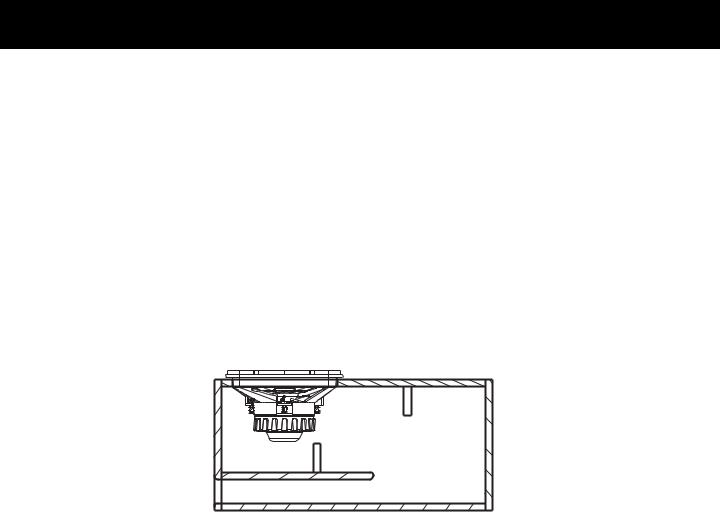
Characteristics of Vented Enclosures
A vented enclosure is not much more complex than a sealed box. It consists, basically, of a box with a hole in it. However, despite its simple design, vented boxes are considerably harder to get good performance from than sealed boxes - although many times the extra effort can be worth it.
The vent in the enclosure interacts with the volume of air in the cabinet and with the driver to help increase output and reduce cone excursion at and around the tuning frequency. In fact, at box tuning, almost all the bass is produced by the vent - NOT the woofer.
The trick in building a vented box is to get the right size enclosure and the right size vent. You can’t be too far off on either of these factors or your speaker’s performance will suffer. In particular, using a too-small box or a toohigh vent tuning frequency can eliminate bass instead of increasing it. Porting a sealed box that is too small usually does nothing to improve frequency response. The vent placement within the enclosure is also important. You must leave at least the equivalent of the vent’s diameter between the vent and any inside wall. For example, you would not place a vent with a -3” diameter within 3” of any wall. The same is true for clearance between the vent opening and the bottom of the enclosure.
Pros
1 - Reduced cone excursion and reduced distortion around vent tuning. 2 - Increased output capabilities around vent tuning.
3 - Vented boxes give you that extra “Bump” that is preferred in certain types of music.
Cons
1 - Total loss of cone control below vent tuning, which can result in high distortion and driver mechanical failure. 2 - Midrange sound coming from inside the box through the vent can produce unpleasant sound coloration.
3 - Vented enclosures are more sensitive to changes such as temperature, humidity and driver fatigue.
4 - Enclosure design is more complex and the enclosure itself must be more solidly constructed because internal pressure at frequencies around vent tuning can be nearly twice as high as a sealed enclosure.
5 - Vented enclosures usually don’t sound as fast as sealed boxes because of the resonant effects of the vent tuning, which is always slightly out of phase with the driver’s output.
Kicker Solo-Baric L5-Series Subwoofers
Recommended Applications
Page 11
